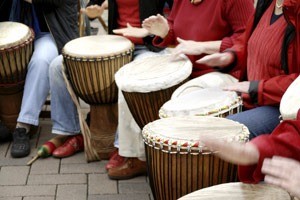 Music Therapy, like other forms of therapy, does not conform its practitioners to one model. Here at Roman Music Therapy Services, we use an integrated model. Clients to come to us with unique needs and we work together with them to create a success-oriented plan that helps them meet their personal goals drawing from multiple ways of thinking about music therapy. There are many different models of music therapy that echo current research and evidence based practice. Our music therapist chooses a model of practice or uses a variety of music therapy strategies and interventions according to what benefits the client. It is also important that when seeking a music therapist, a client is well informed and can find a therapist that is right for them.
Music Therapy, like other forms of therapy, does not conform its practitioners to one model. Here at Roman Music Therapy Services, we use an integrated model. Clients to come to us with unique needs and we work together with them to create a success-oriented plan that helps them meet their personal goals drawing from multiple ways of thinking about music therapy. There are many different models of music therapy that echo current research and evidence based practice. Our music therapist chooses a model of practice or uses a variety of music therapy strategies and interventions according to what benefits the client. It is also important that when seeking a music therapist, a client is well informed and can find a therapist that is right for them.
According to Meredith Pizzi, MT-BC, the way of practicing at Roman Music Therapy Services is also closely aligned with the needs of the community.
Our work here at Roman Music Therapy Services is deeply rooted in the communities of the schools, agencies and families we serve. As a community music therapy agency, our clinical work tends to focus on the needs of the community or the individual within their community. Whether we are providing individual services, family-based afterschool groups, or group music therapy services in a school, nursing home, adult day health program, our team is always considering the needs of the individual in relationship to the world and environment around them. We believe that our work in music therapy sessions with our clients can create ripple effects in the home, schools, and in all of our communities. We also believe that by providing services in community settings, we can better support our clients in their own personal and interpersonal growth with opportunities for engagement and meaningful relationships within their communities. Our work is goal driven, focused on the needs of the individual or group members and uses all of the tools of music to help our clients reach their goals. We believe that the work that we do can best be defined as Community Music Therapy. -Meredith R. Pizzi, MT-BC
As our Mission Statement says,
Roman Music Therapy Services strives to meet the diverse needs of the community within schools, nursing homes, senior centers, and community health and service agencies through music therapy experiences, education, and resources. Our team of music therapists use the power of music to support personal and interpersonal growth and enhance the life of the community. Using musical tools, new possibilities and opportunities are created for our clients to reach their full potential.
Other models of Music Therapy
Nordoff Robbins Music Therapy (NRMT)
Perhaps one of the most well research and well-documented models of music therapy, Nordoff Robbins Music Therapy or NRMT was developed by Dr. Paul Nordoff and Dr. Clive Robbins in 1961. NRMT is centered on “the belief that everyone possesses a sensitivity to music that can be utilized for personal growth and development”. NRMT allows music therapists and clients to come together in an active music-making environment that fosters success through support and expression. NRMT is famous for its work with children with special needs, but is also suitable for use with individuals searching for creative personal development, and those in psychiatric settings.
For more information please head to their website: https://steinhardt.nyu.edu/nordoff/training-programs
Neurologic Music Therapy (NMT)
Developed at Colorado State University by Michael Thaut PhD, NMT uses music therapeutically to stimulate patients with neurologic diseases that affect the nervous system. This research-based therapy is founded in the science of music effects on the “nonmusical brain”. NMT’s four focus areas are as follows: Cognition, sensory, speech, and movement/coordination. NMT methods are used in many settings, some of the most common populations include: Alzheimer’s, Autism, Parkinson’s, stroke, traumatic brain injury, and many more.
For more information please visit their website: https://www.colostate.edu/dept/cbrm/institute.htm
The Bonny Method of Guided Imagery and Music (GIM)
Developed by Helen Lindquist Bonny (1921-2010), the Bonny Method of Guided of Imagery and Music or GIM, is described as a “music-centered exploration of consciousness” using “specifically sequenced” music to stimulate imagery experiences. There is openness in this practice established by the therapist and client. Goals and focus of the session are determined together in efforts to accomplish the meeting the needs of the individual. Sessions are one-to-one and can last up to two hours. A client is lead through a guided relaxation, which leads into the exploration of “deeper state of consciousness” through the use of classical western music. The experience is then discussed in an open format with the therapist to help further develop an understanding of the inner self.
For more information please head to their website: https://ami-bonnymethod.org
Aside from the three listed above, there are many other methods of practicing music therapy, and most are individualized by the therapist adapted to fit the needs of their clients. Some other methods of music therapy include:
- Analytical Music Therapy
- Behavioral Music Therapy
- Benenzon Music Therapy
- Clinical Orff Schulwerk Music Therapy
- Free Improvisation Music Therapy
Click on the names above to find out more about what each method has to offer.
